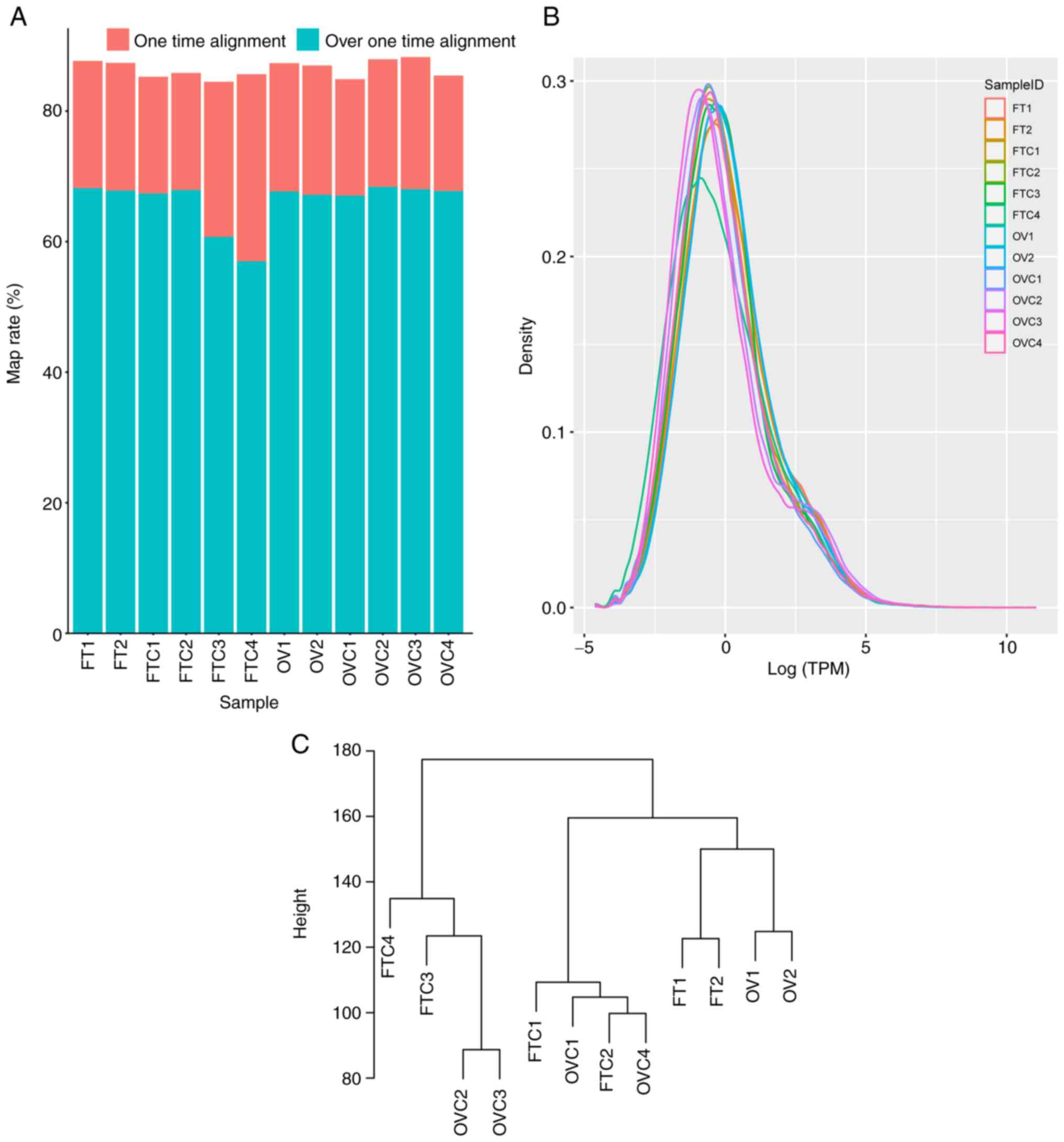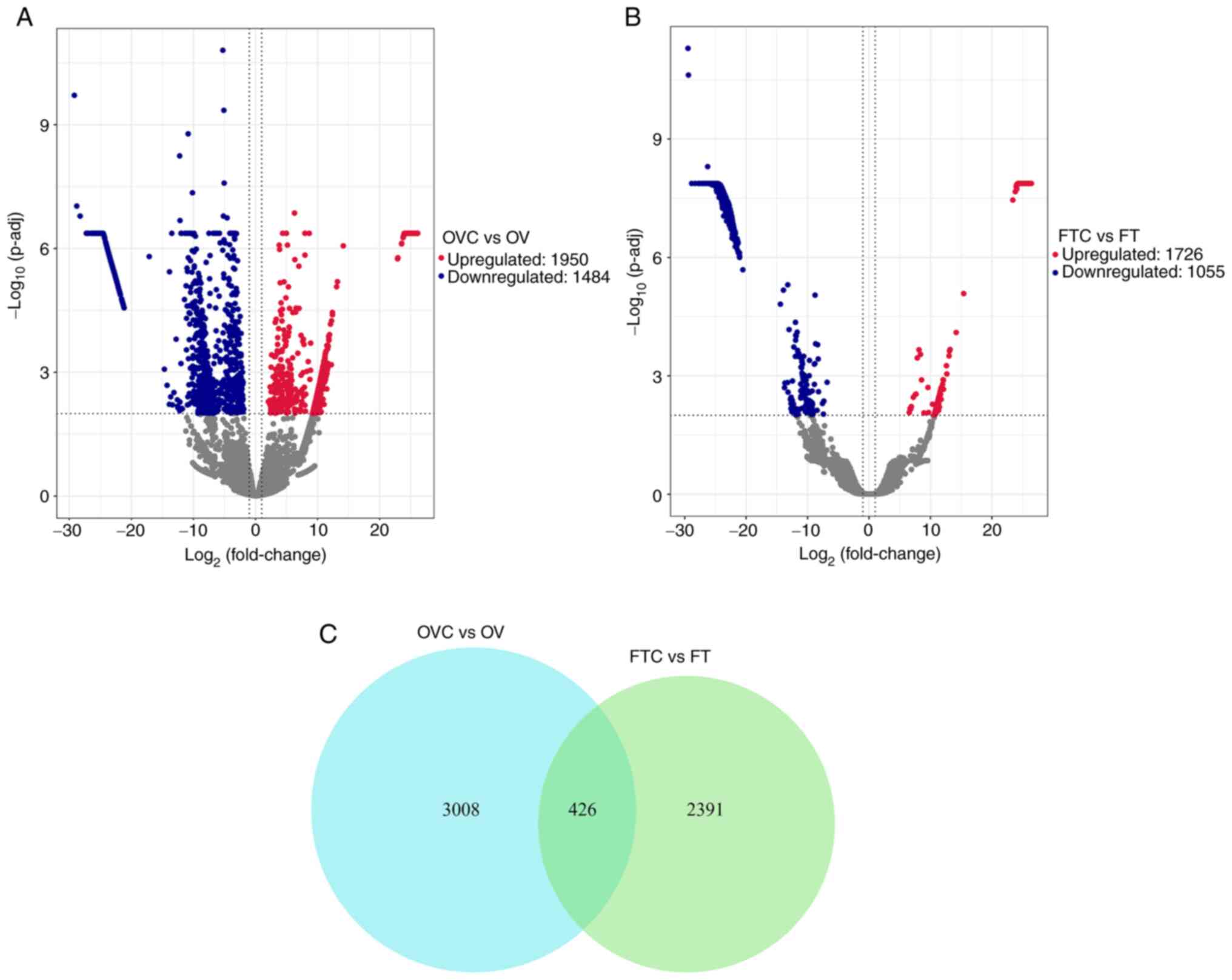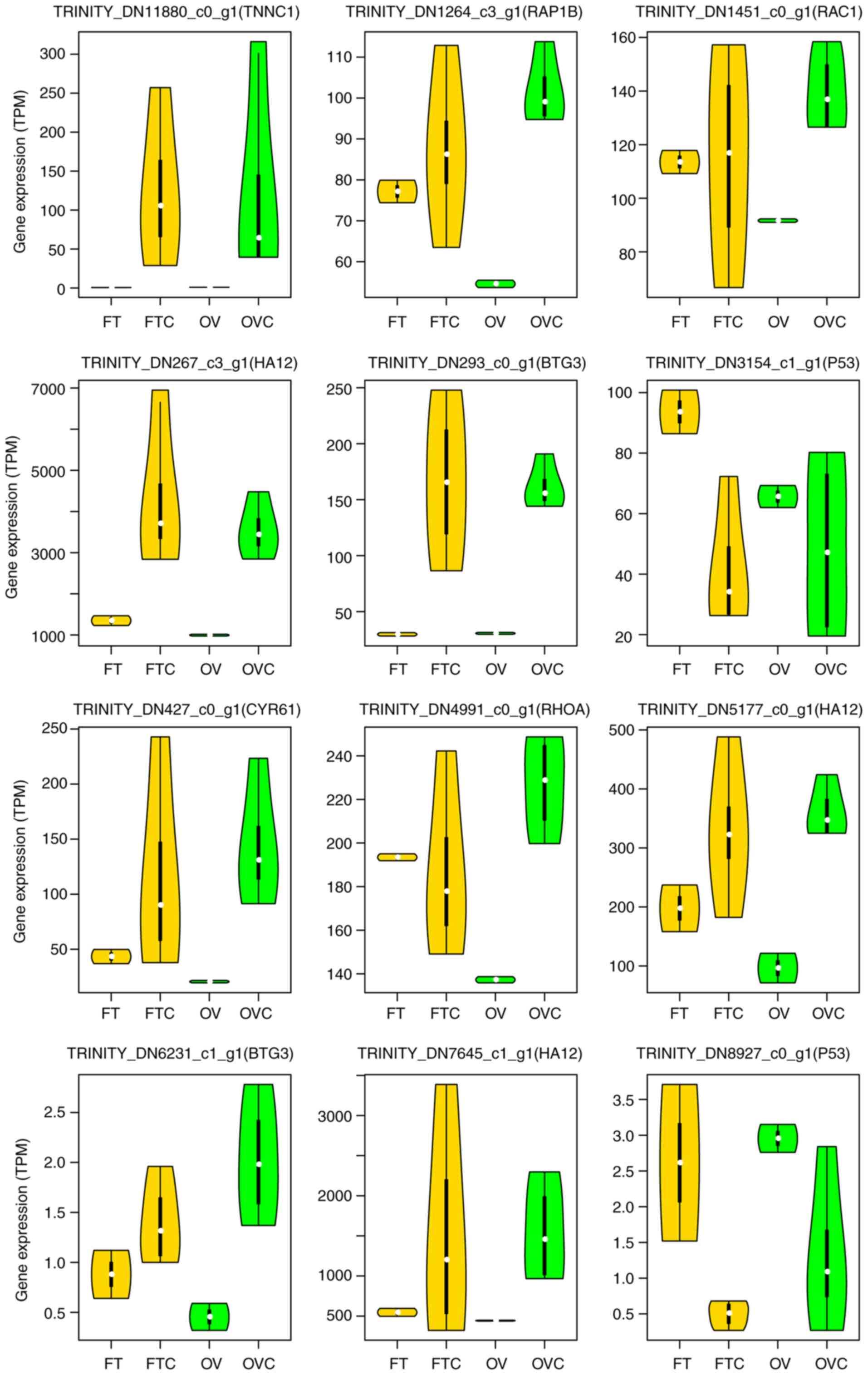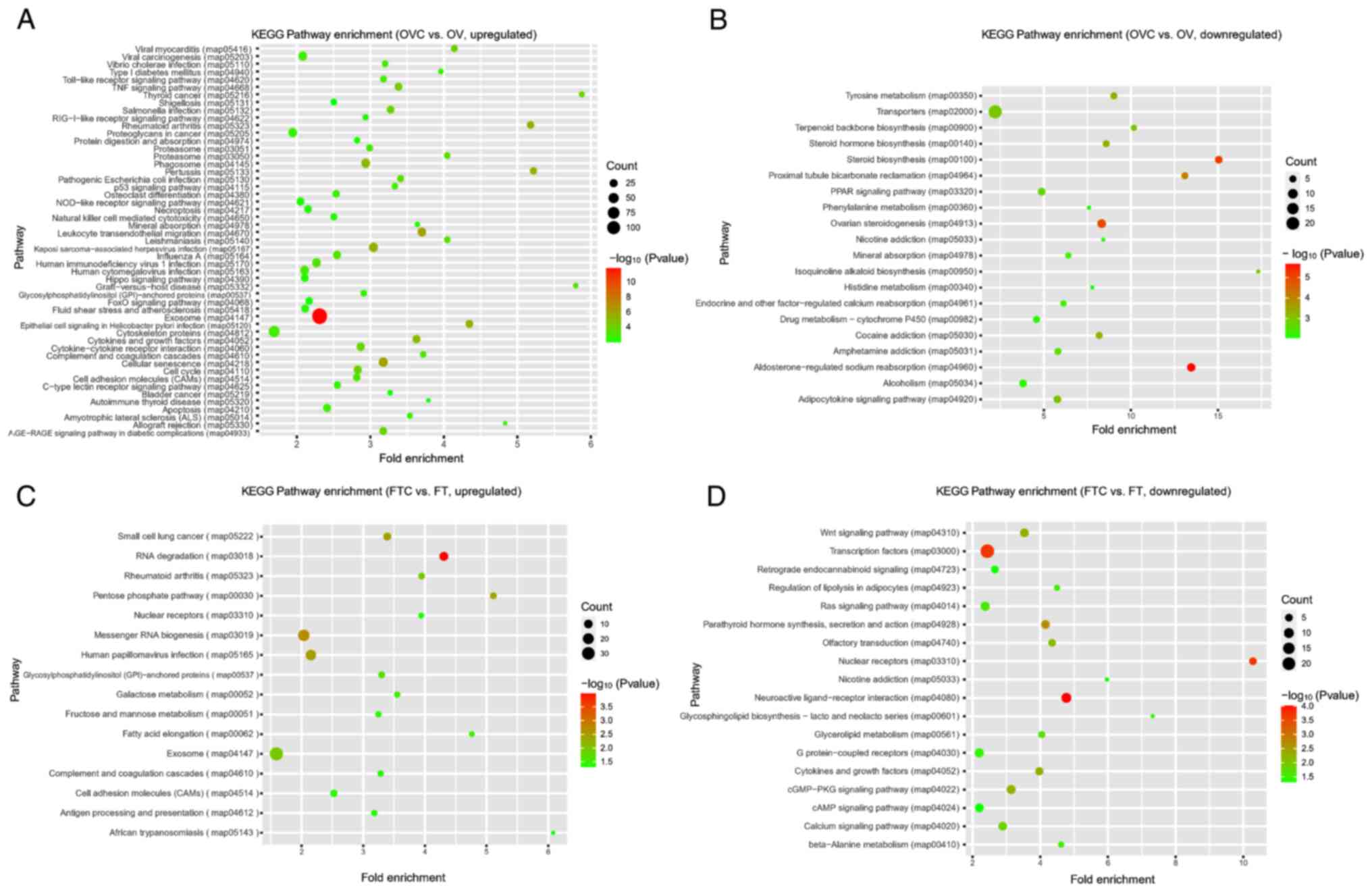|
1
|
Chen W, Zheng R, Baade PD, Zhang S, Zeng
H, Bray F, Jemal A, Yu XQ and He J: Cancer statistics in China,
2015. CA Cancer J Clin. 66:115–132. 2016. View Article : Google Scholar : PubMed/NCBI
|
|
2
|
Ishizuka B: Current Understanding of the
etiology, symptomatology, and treatment options in premature
ovarian insufficiency (POI). Front Endocrinol (Lausanne).
12:6269242021. View Article : Google Scholar : PubMed/NCBI
|
|
3
|
Chen SN, Chang R, Lin LT, Chern CU, Tsai
HW, Wen ZH, Li YH, Li CJ and Tsui KH: MicroRNA in ovarian cancer:
Biology, pathogenesis, and therapeutic opportunities. Int J Environ
Res Public Health. 16:15102019. View Article : Google Scholar : PubMed/NCBI
|
|
4
|
Stewart C, Ralyea C and Lockwood S:
Ovarian cancer: An integrated review. Semin Oncol Nurs. 35:151–156.
2019. View Article : Google Scholar : PubMed/NCBI
|
|
5
|
Lutgendorf SK and Sood AK: Biobehavioral
factors and cancer progression: Physiological pathways and
mechanisms. Psychosom Med. 73:724–730. 2011. View Article : Google Scholar : PubMed/NCBI
|
|
6
|
Bigorie V, Morice P, Duvillard P, Antoine
M, Cortez A, Flejou JF, Uzan S, Darai E and Barranger E: Ovarian
metastases from breast cancer: Report of 29 cases. Cancer.
116:799–804. 2010. View Article : Google Scholar : PubMed/NCBI
|
|
7
|
Mikula-Pietrasik J, Uruski P, Tykarski A
and Książek K: The peritoneal ‘soil’ for a cancerous ‘seed’: A
comprehensive review of the pathogenesis of intraperitoneal cancer
metastases. Cell Mol Life Sci. 75:509–525. 2018. View Article : Google Scholar : PubMed/NCBI
|
|
8
|
Parashar D, Nair B, Geethadevi A, George
J, Nair A, Tsaih SW, Kadamberi IP, Gopinadhan Nair GK, Lu Y,
Ramchandran R, et al: Peritoneal spread of ovarian cancer harbors
therapeutic vulnerabilities regulated by FOXM1 and EGFR/ERBB2
signaling. Cancer Res. 80:5554–5568. 2020. View Article : Google Scholar : PubMed/NCBI
|
|
9
|
Levy A, Medjhoul A, Caramella C, Zareski
E, Berges O, Chargari C, Boulet B, Bidault F, Dromain C and
Balleyguier C: Interest of diffusion-weighted echo-planar MR
imaging and apparent diffusion coefficient mapping in gynecological
malignancies: A review. J Magn Reson Imaging. 33:1020–1027. 2011.
View Article : Google Scholar : PubMed/NCBI
|
|
10
|
Li Z, Zheng W, Wang H, Cheng Y, Fang Y, Wu
F, Sun G, Sun G, Lv C and Hui B: Application of animal models in
cancer research: Recent progress and future prospects. Cancer Manag
Res. 13:2455–2475. 2021. View Article : Google Scholar : PubMed/NCBI
|
|
11
|
Overgaard NH, Fan TM, Schachtschneider KM,
Principe DR, Schook LB and Jungersen G: Of Mice, Dogs, Pigs, and
Men: Choosing the appropriate model for immuno-oncology research.
ILAR J. 59:247–262. 2018. View Article : Google Scholar : PubMed/NCBI
|
|
12
|
Jayson GC, Kohn EC, Kitchener HC and
Ledermann JA: Ovarian cancer. Lancet. 384:1376–1388. 2014.
View Article : Google Scholar : PubMed/NCBI
|
|
13
|
Katt ME, Placone AL, Wong AD, Xu ZS and
Searson PC: In Vitro tumor models: Advantages, disadvantages,
variables, and selecting the right platform. Front Bioeng
Biotechnol. 4:122016. View Article : Google Scholar : PubMed/NCBI
|
|
14
|
Kamdem JP, Duarte AE, Ibrahim M, Lukong
KE, Barros LM and Roeder T: Bibliometric analysis of personalized
humanized mouse and Drosophila models for effective
combinational therapy in cancer patients. Biochim Biophys Acta Mol
Basis Dis. 1866:1658802020. View Article : Google Scholar : PubMed/NCBI
|
|
15
|
Yu YJ, Su ZJ, Zhou ZJ and Ma YD:
Pathological observation on spontaneous epithelial ovarian cancer
in reed vole. Chin J V Sci. 1070–1073. 2008.(In Chinese).
|
|
16
|
Zhou ZJ, Yu YJ, Su ZJ and Tang LF:
Expression of heat shock proteins HSP27, HSP70 and HSP90 in
spontaneous ovarian cancer of Microtus fortis. Chin J Comp
Med. 4:26–28. 2005.(In Chinese).
|
|
17
|
Yu Y: An investigation of pathological
changes in Captive-bred Microtus fortis. Chin J Zool.
38:71–73. 2003.(In Chinese).
|
|
18
|
Zheng M, Hu Y, Gou R, Nie X, Li X, Liu J
and Lin B: Identification three LncRNA prognostic signature of
ovarian cancer based on genome-wide copy number variation. Biomed
Pharmacother. 124:1098102020. View Article : Google Scholar : PubMed/NCBI
|
|
19
|
Hu Y, Xu Y, Lu W, Yuan Z, Quan H, Shen Y
and Cao J: De novo assembly and transcriptome
characterization: Novel insights into the natural resistance
mechanisms of Microtus fortis against Schistosoma japonicum.
BMC Genomics. 15:4172014. View Article : Google Scholar : PubMed/NCBI
|
|
20
|
Marquardt N, Feja M, Hünigen H, Plendl J,
Menken L, Fink H and Bert B: Euthanasia of laboratory mice: Are
isoflurane and sevoflurane real alternatives to carbon dioxide?
PLoS One. 13:e02037932018. View Article : Google Scholar : PubMed/NCBI
|
|
21
|
Laferriere CA, Leung VS and Pang DS:
Evaluating intrahepatic and intraperitoneal sodium pentobarbital or
ethanol for mouse euthanasia. J Am Assoc Lab Anim Sci. 59:264–268.
2020. View Article : Google Scholar : PubMed/NCBI
|
|
22
|
Bolger AM, Lohse M and Usadel B:
Trimmomatic: A flexible trimmer for Illumina sequence data.
Bioinformatics. 30:2114–2120. 2014. View Article : Google Scholar : PubMed/NCBI
|
|
23
|
Grabherr MG, Haas BJ, Yassour M, Levin JZ,
Thompson DA, Amit I, Adiconis X, Fan L, Raychowdhury R, Zeng Q, et
al: Full-length transcriptome assembly from RNA-Seq data without a
reference genome. Nat Biotechnol. 29:644–652. 2011. View Article : Google Scholar : PubMed/NCBI
|
|
24
|
R Core Team: R: A Language and Environment
for Statistical Computing. R Foundation for Statistical Computing,
Vienna, Austria. Computing,. 14:pp12–21. 2009.
|
|
25
|
Eddy SR: Profile hidden markov models.
Bioinformatics. 14:755–763. 1998. View Article : Google Scholar : PubMed/NCBI
|
|
26
|
Almagro Armenteros JJ, Tsirigos KD,
Sønderby CK, Petersen TN, Winther O, Brunak S, von Heijne G and
Nielsen H: SignalP 5.0 improves signal peptide predictions using
deep neural networks. Nat Biotechnol. 37:420–423. 2019. View Article : Google Scholar : PubMed/NCBI
|
|
27
|
Love MI, Huber W and Anders S: Moderated
estimation of fold change and dispersion for RNA-seq data with
DESeq2. Genome Biol. 15:5502014. View Article : Google Scholar : PubMed/NCBI
|
|
28
|
Langmead B and Salzberg SL: Fast
gapped-read alignment with Bowtie 2. Nat Methods. 9:357–359. 2012.
View Article : Google Scholar : PubMed/NCBI
|
|
29
|
Li B and Dewey CN: RSEM: Accurate
transcript quantification from RNA-Seq data with or without a
reference genome. BMC Bioinformatics. 12:3232011. View Article : Google Scholar : PubMed/NCBI
|
|
30
|
Leung CS, Yeung TL, Yip KP, Pradeep S,
Balasubramanian L, Liu J, Wong KK, Mangala LS, Armaiz-Pena GN,
Lopez-Berestein G, et al: Calcium-dependent FAK/CREB/TNNC1
signalling mediates the effect of stromal MFAP5 on ovarian cancer
metastatic potential. Nat Commun. 5:50922014. View Article : Google Scholar : PubMed/NCBI
|
|
31
|
Takahashi Y, Li L, Kamiryo M, Asteriou T,
Moustakas A, Yamashita H and Heldin P: Hyaluronan fragments induce
endothelial cell differentiation in a CD44- and
CXCL1/GRO1-dependent manner. J Biol Chem. 280:24195–24204. 2005.
View Article : Google Scholar : PubMed/NCBI
|
|
32
|
Onaciu A, Munteanu R, Munteanu VC, Gulei
D, Raduly L, Feder RI, Pirlog R, Atanasov AG, Korban SS, Irimie A
and Berindan-Neagoe I: Spontaneous and induced animal models for
cancer research. Diagnostics (Basel). 10:6602020. View Article : Google Scholar : PubMed/NCBI
|
|
33
|
Cicalese A, Bonizzi G, Pasi CE, Faretta M,
Ronzoni S, Giulini B, Brisken C, Minucci S, Di Fiore PP and Pelicci
PG: The tumor suppressor p53 regulates polarity of self-renewing
divisions in mammary stem cells. Cell. 138:1083–1095. 2009.
View Article : Google Scholar : PubMed/NCBI
|
|
34
|
Yue XT, Zhao Y, Xu Y, Zheng M, Feng Z and
Hu W: Mutant p53 in Cancer: Accumulation, Gain-of-function, and
therapy. J Mol Biol. 429:1595–1606. 2017. View Article : Google Scholar : PubMed/NCBI
|
|
35
|
Barkal AA, Brewer RE, Markovic M, Kowarsky
M, Barkal SA, Zaro BW, Krishnan V, Hatakeyama J, Dorigo O, Barkal
LJ and Weissman IL: CD24 signalling through macrophage Siglec-10 is
a target for cancer immunotherapy. Nature. 572:392–396. 2019.
View Article : Google Scholar : PubMed/NCBI
|
|
36
|
Lee KB, Byun HJ, Park SH, Park CY, Lee SH
and Rho SB: CYR61 controls p53 and NF-κB expression through
PI3K/Akt/mTOR pathways in carboplatin-induced ovarian cancer cells.
Cancer Lett. 315:86–95. 2012. View Article : Google Scholar : PubMed/NCBI
|
|
37
|
von Karstedt S, Conti A, Nobis M,
Montinaro A, Hartwig T, Lemke J, Legler K, Annewanter F, Campbell
AD, Taraborrelli L, et al: Cancer cell-autonomous TRAIL-R signaling
promotes KRAS-driven cancer progression, invasion, and metastasis.
Cancer Cell. 27:561–573. 2015. View Article : Google Scholar : PubMed/NCBI
|
|
38
|
Lin KT, Yeh YM, Chuang CM, Yang SY, Chang
JW, Sun SP, Wang YS, Chao KC and Wang LH: Glucocorticoids mediate
induction of microRNA-708 to suppress ovarian cancer metastasis
through targeting Rap1B. Nat Commun. 6:59172015. View Article : Google Scholar : PubMed/NCBI
|
|
39
|
Leng R, Liao G, Wang H, Kuang J and Tang
L: Rac1 expression in epithelial ovarian cancer: Effect on cell EMT
and clinical outcome. Med Oncol. 32:3292015. View Article : Google Scholar : PubMed/NCBI
|
|
40
|
Ren XL, Zhu XH, Li XM, Li YL, Wang JM, Wu
PX, Lv ZB, Ma WH, Liao WT, Wang W, et al: Down-regulation of BTG3
promotes cell proliferation, migration and invasion and predicts
survival in gastric cancer. J Cancer Res Clin Oncol. 141:397–405.
2015. View Article : Google Scholar : PubMed/NCBI
|
|
41
|
Mao D, Qiao L, Lu H and Feng Y: B-cell
translocation gene 3 overexpression inhibits proliferation and
invasion of colorectal cancer SW480 cells via Wnt/β-catenin
signaling pathway. Neoplasma. 63:705–716. 2016. View Article : Google Scholar : PubMed/NCBI
|
|
42
|
Deng B, Zhao Y, Gou W, Chen S, Mao X,
Takano Y and Zheng H: Decreased expression of BTG3 was linked to
carcinogenesis, aggressiveness, and prognosis of ovarian carcinoma.
Tumor Biol. 34:2617–2624. 2013. View Article : Google Scholar : PubMed/NCBI
|
|
43
|
Bai Y, Qiao L, Xie N, Shi Y, Liu N and
Wang J: Expression and prognosis analyses of the Tob/BTG
antiproliferative (APRO) protein family in human cancers. PLoS One.
12:e01849022017. View Article : Google Scholar : PubMed/NCBI
|
|
44
|
Liu T, Yang Y, Xie Z, Luo Q, Yang D, Liu
X, Zhao H, Wei Q, Liu Y, Li L, et al: The RNA binding protein QKI5
suppresses ovarian cancer via downregulating transcriptional
coactivator TAZ. Mol Ther Nucleic Acids. 26:388–400. 2021.
View Article : Google Scholar : PubMed/NCBI
|
|
45
|
Cui G, Wang C, Lin Z, Feng X, Wei M, Miao
Z, Sun Z and Wei F: Prognostic and immunological role of
Ras-related protein Rap1b in pan-cancer. Bioengineered.
12:4828–4840. 2021. View Article : Google Scholar : PubMed/NCBI
|
|
46
|
Wei X, Lou H, Zhou D, Jia Y, Li H, Huang
Q, Ma J, Yang Z, Sun C, Meng Y, et al: TAGLN mediated
stiffness-regulated ovarian cancer progression via RhoA/ROCK
pathway. J Exp Clin Cancer Res. 40:2922021. View Article : Google Scholar : PubMed/NCBI
|
|
47
|
Wang X, Wei Z, Tang Z, Xue C, Yu H, Zhang
D, Li Y, Liu X, Shi Y, Zhang L, et al: IL-37bΔ1-45 suppresses the
migration and invasion of endometrial cancer cells by targeting the
Rac1/NF-κB/MMP2 signal pathway. Lab Invest. 101:760–774. 2021.
View Article : Google Scholar : PubMed/NCBI
|
|
48
|
Yanagida S, Taniue K, Sugimasa H, Nasu E,
Takeda Y, Kobayashi M, Yamamoto T, Okamoto A and Akiyama T: ASBEL,
an ANA/BTG3 antisense transcript required for tumorigenicity of
ovarian carcinoma. Sci Rep. 3:13052013. View Article : Google Scholar : PubMed/NCBI
|













